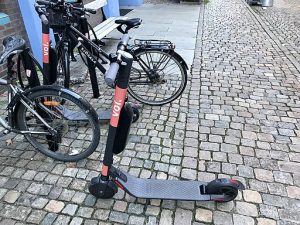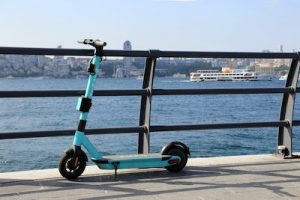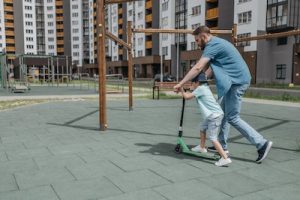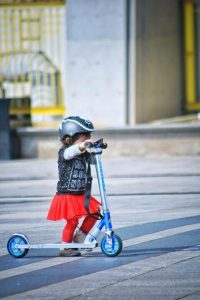We all know how much kids love the thrill of zipping everywhere. However, selecting the perfect scooter ride from the wide range of the kids scooter options can be daunting, especially given the numerous choices available.
At FamilyHype, we’re here to help you navigate the world of the best kids scooters, ensuring that your little ones have fun on scooters while staying as safe as possible. This comprehensive guide explores different kids scooters, considerations for the child’s age and skill level, plus essential safety features to ensure a smooth ride.
We’ll also delve into scooters’ size and weight limit, material durability, and value for money. Plus, we’ll highlight some top kids scooters and offer tips on maintaining these rides and teaching kids safe riding habits. We invite you to share your feedback on our content, your experience making a scooter purchase, and your opinions on scooters for kids.
To help you find the right scooter that will provide endless fun and foster a sense of independence and confidence in your child, consider factors such as brand, design, speed, portability, durability, and price. We recommend Razor A5 Lux, Micro Mini, and Fuzion, which are known to have high-quality, reliable, and safe models.

Find the perfect scooter to make your child’s dreams come true!
Key Takeaways
- Consider the child’s age and skill level when choosing a scooter, as scooter size and weight limitations impact the child’s stability and even maneuverability.
- Look for reliable brake systems and helmet compatibility as important safety scooter features for your kids.
- Opt for customization options that allow for adjustable scooter settings and growing with the kids.
- When selecting a scooter, consider scooter material durability, scooter, and kid’s comfort, as well as design, price, warranties, and resale value.
Right Scooters For Kids
You have to know that not all scooters are created equal. Let’s explore the fascinating world of different types of scooters for kids.
We’ll encounter several variations in our journey, each with unique attributes catering to different needs. The creative customization of scooters can be a fun way to express their personality. They can choose from various colors and designs or deck their ride with cool accessories.
Some parts that you should pay attention to are the motor skills, the foot and hand brakes, the flexible fiberglass reinforced deck, the adjustable T bar, and the ride quality. These factors can affect the scooter’s performance, safety, comfort, and durability.
For instance, motor skills are important for controlling the speed and direction of the scooter, and they can be improved with practice and training. Foot and hand brakes are essential for stopping the scooter safely and smoothly, and they can vary in design and effectiveness.
A flexible fiberglass-reinforced deck can provide more stability and shock absorption, making the ride smoother and more comfortable. An adjustable T-bar allows you to customize the height and angle of the handlebar, which can affect the rider’s balance and posture.
Finally, ride quality can depend on the type and size of the wheels, the battery life and charging time, the scooter’s weight and portability, and its overall design and appearance.
Now, let’s not forget our responsibility towards our planet. Some scooters are made from eco-friendly materials, reducing the environmental impact. This helps us teach our kids about sustainability while having fun. Ensuring the right choice involves considering the fun factor, safety, and sustainability.
Remember how kids’ age and skill level influence the most suitable scooter choice as we progress.
Right Age And Skills For Riding A Scooter
Before your little kids hop on their two-wheeled scooters, it’s crucial to consider their age and skill level to ensure a thrilling yet secure scooting adventure. Young beginners may find a three-wheel scooter more stable, while older kids might prefer a two-wheel scooter for added maneuverability.
The significance of these considerations extends beyond the scooter’s type and size. It’s also about instilling the importance of helmets and the need for protective gear. Teach your kids early that safety is as important as fun. Small steps like wearing a helmet and knee and elbow pads can prevent injuries and build a foundation of responsible riding habits.
Now that we’ve emphasized age-appropriate choices for kids and safety let’s explore the best wheels for riding a scooter and delve into the specific safety features to look out for in the perfect scooter.
Safety Features For Kids
When picking out the best kids scooters, it’s crucial to prioritize safety features that will protect your little one during their scooting escapades. A well-designed kids scooter should include reliable brake systems for scooters. These come in various forms, such as hand brakes or rear wheel brakes, both designed to give your kids control over their speeds on their kick scooter.
Helmet compatibility is another key safety feature of scooters. The best scooter for kids should have enough headroom to accommodate a helmet, ensuring safety for your kids on every ride. Look for scooters with an adjustable handlebar and adjustable height handlebars to ensure a proper fit as your child grows.
We can’t stress enough the importance of these safety precautions when selecting the best kid scooters, like a kick scooter with high-quality features.
Not only do they protect your kids, ensuring a smooth ride and adjustable height suitable for their age range and weight limit on the kids scooter, but they also give you peace of mind with added safety features such as LED lights and the ability to lean to steer confidently on a wheel scooter.
Best Scooter Size & Scooter Weight Limitations
Let’s consider the importance of size and weight limitations in ensuring your child’s best kids scooters deliver optimal performance. These factors significantly impact the stability and maneuverability of kick scooters for kids, making it crucial to find a model perfect for your child’s physical stature.
- Scooter customization: Some kids scooters feature adjustable height handlebars and handlebar height settings, enabling the scooter to adapt as your kid grows and ensuring a comfortable and smooth ride for kids every time. Models like the Micro Mini Deluxe are designed with this in mind, offering flexibility and comfort for younger kids and younger riders.
- Check the weight limit: It is vital to select a kids scooter that can easily handle your kid’s weight. Overloading a scooter can impair its performance and pose safety risks to both the kid and the scooter. Options like the Razor A5 Lux, with its sturdy construction and larger wheels, cater to big kids and provide enhanced stability.
Size and weight limitations aren’t just about comfort on scooters; they’re about scooters safety for kids, too. A scooter for your child with polyurethane wheels and adjustable handlebar ensures that the ride is both enjoyable and safe. Light up wheels and LED lights add visibility, making these scooters ideal for a fun and secure ride.
Next, let’s examine the role material and durability play in your kids’ overall experience on scooters. Selecting durable materials and understanding the scooter’s age range compatibility can help maintain a safe and enjoyable riding experience. A folding mechanism adds convenience, making it easy to store and transport the scooter, while kick scooters with lean to steer functionality help in developing balance and coordination for young riders.
Best Scooter Material & Scooter Durability
You can’t overlook the importance of material and durability in kids scooters, as these factors play a huge role in the scooters’ lifespan and usability.
A sturdy kick scooter for kids can withstand the wear and tear of regular use and the occasional tumble. Recycled materials offer an eco-friendly option, providing the added advantage of being kind to the environment while ensuring your child’s ride is robust.
Many durable scooters for kids are made from high-grade aluminum and reinforced steel. Some models of kids scooters even incorporate bamboo and other sustainable materials, making them green choices. These sturdy, eco-friendly options are built to last and help inculcate a sense of environmental responsibility in your child.

Moving into considerations of comfort and design, remember that well-constructed scooters don’t necessarily have to compromise on the best aesthetics for the scooters. A Mini Deluxe scooter, for instance, can offer a smooth ride and durability while featuring a design that appeals to younger riders.
The weight limit, handlebar height, and adjustable height settings should be taken into account while choosing the best kids scooters. The tiny scooter and other models with adjustable height handlebars and adjustable handlebar options and heights guarantee that the mini scooter may grow with your child and offer a smooth ride for both young riders and big kids.
Not only do polyurethane wheels, light up wheels, and LED lights improve the scooter’s appearance, but they also improve visibility and safety, especially for kids electric scooters. While lean to steer capability aids in younger riders with balance and coordination development, a dependable folding mechanism adds convenience and makes the scooter easy to store and move.
To guarantee your child has a safe and pleasurable riding experience, always give top priority to excellent materials and durability when shopping for the best kids scooters. A kick scooter, wheel scooter, or Mini Deluxe—the best option will provide longevity and a smooth ride.
Scooter Comfort & Scooter Safety
Comfort and design are equally essential in kids scooters, ensuring an enjoyable and smooth ride every time they hop on. We can’t overstate the importance of an adjustable handlebar. It ensures a proper fit for your child, providing stability and control as they navigate their fun-filled adventures.
Next, let’s talk about scooter customization. A scooter for your child that reflects their personality and interests is more likely to excite them about riding. It also gives them a sense of ownership and pride. From vibrant colors to unique patterns, the design options are endless.
- Personalized Stickers and Decals For Kids Scooter: Choose from a variety of scooter stickers and scooter decals to personalize your kids scooter. Themes can range from kid’s favorite cartoon characters to cool abstract scooter designs.
- Custom Handlebar Grips For Kid’s Scooter: Upgrade the standard scooter grips to comfortable ones in unique colors and patterns, adding a fun twist.
- Specialized Wheel Designs For Kid’s Scooter: Choose standout polyurethane wheels, brightly colored or patterned for scooters, perhaps with scooter LED lights, adding an extra cool touch.
Remember, a well-designed, comfortable scooter can make your child’s ride safer and more fun. As we discuss ‘price and value for money,’ remember that a scooter’s comfort and design are worth considering in your budgeting. Features like an adjustable handlebar, adjustable height handlebars, and height handlebars are essential for accommodating young riders and big kids alike.
Scooter Price & Scooter Value
Investing in the best scooters for your kids isn’t about splurging on the priciest model; it’s about balancing cost and quality. In this search about balance, two key things to consider are scooter warranties and resale value.
Warranties give us peace of mind and guarantee that if something goes wrong, we’re protected. They speak volumes about the manufacturer’s confidence in the durability and safety of their soundest scooters.
On the other hand, resale value is an important factor if we’re considering upgrading as our kids grow and their riding skills improve. A scooter with a good resale value means we can recoup some of our investment when it’s time to move on.
With these considerations in mind, let’s delve into the world of top kids’ scooter brands, including those that offer high-quality electric scooters. Brands that provide scooters with features such as kick scooters, wheel scooters, folding mechanism, and light up wheels cater to a wide age range and skill level.
Guide For Choosing The Right Scooter Brands For Kids
Let’s jump in and explore the top-notch, best scooter brands that offer the most bang for your buck regarding children’s scooters. Brand reputation is critical in ensuring quality and safety. Razor, Micro, and Radio Flyer are well-known for their reliable and durable scooters. These brands continually innovate, introducing features like adjustable handlebars, lean-to-Lar design, robust braking systems, and stable three-wheel designs, perfect for kids.
- Adjustable Scooter Handlebars For Kids: These enable the scooter to grow with your kid, ensuring years of comfortable and ergonomic use.
- Lean to Steer Scooter Mechanism For Kids: This intuitive design fosters balance and coordination development, making it convenient for kids.
- Enhanced Scooter Safety Features For Kids: Choose scooters with robust braking systems, non-slip decks, and stable wheel designs, which ensure maximum kid safety when scootering.
These brands’ innovative features aren’t just about fun, safety, and longevity. So, when you invest in these quality brands, you’re not just buying a toy but investing in your child’s fun, fitness, and overall safety.
For younger kids, a mini scooter with LED lights can make the riding experience even more enjoyable. The flashing lights not only look cool but also increase visibility, ensuring your child is seen while riding.
Wheel scooters and kids electric scooters are also excellent options, providing smooth rides and easy maneuverability. Brands like Razor offer wheel scooters with durable polyurethane wheels and kids electric models that combine fun and convenience.
With the best brand in hand, next, we’ll delve into maintaining your child’s wheel scooter for lasting fun. This includes regular check-ups for wear and tear, understanding the importance of proper storage, and tips for cleaning and caring for their ride. We’ll also discuss the significance of teaching your child about safety and maintenance, fostering a sense of responsibility, and ensuring the ride-on remains in top condition for years of enjoyment.
Maintenance Tips And Ideas
To keep your little one zooming around the neighborhood, it’s essential to maintain their scooter in top-notch condition. Regular upkeep prolongs the scooter’s life and ensures your child’s safety.
Here are four key areas to focus on:
- Regular scooter inspection: Always check the scooter for any loose screws, worn-out urethane wheels, or other potential hazards for kids.
- Cleaning scooter routines: Regular cleaning prevents dirt and grime build-up, which could affect the scooter’s performance.
- Scooter customization for kids: Adjust the height and handlebars to match your child’s growth. This ensures comfortable and safe rides.
- Proper scooter storage: Store the scooter in a dry, safe place to avoid damage from harsh weather conditions or accidental falls.
Next, we’ll explore how to instill safe scooter riding habits in your child.
Safe Habits Best For Kids On Two-Wheeled Rides
Before they hit the sidewalk, your child must know the ins and outs of responsible scooter use. Let’s hammer home the importance of helmets first. A well-fitted, quality helmet can distinguish between a minor accident and a serious injury. It’s not just about strapping it on; teach them to adjust the straps for a snug fit that sits level on their heads.
Once safety gear is in place, choosing the right wheel scooter is essential. For younger children, a kick scooter with lean-to-steer technology, like the Maxi Deluxe, is ideal because it helps them control the scooter more intuitively while developing great balance and coordination. An electric scooter could be a thrilling option if they’re a bit older.
Additionally, make sure whatever model you choose has an adjustable height feature to grow with them and ensure a comfortable and safe ride.

Next, supervised practice is key. We’re teaching them how to ride and guiding them to react to different situations. Start in a safe, traffic-free zone and gradually introduce them to more complex environments. Encourage them to be aware of their surroundings and always prioritize safety.
Remember, we’re nurturing future responsible riders.
Conclusion
We’ve covered a lot of ground, haven’t we? From understanding the many scooters available and considering age and skill, including the needs of a young child and inexperienced riders, to safety features and more.
Remember, the favorite scooters for your kid match their abilities and ensure safety, including a front wheel suspension to minimize a bumpier ride and deliver the quietest ride possible. Keep an eye on quality, price, and the brand’s reputation. Teach them safe riding habits and ensure proper maintenance of all parts, including the handlebar clamp and wheels. If your child is interested in advancing their skills and perhaps even participating in scooter sports, a pro wheel scooter, often with a max weight capacity and designed for rider shifting, is an excellent option.
We know that wheel scooters come in all shapes and sizes, from traditional kick to electric scooters. We also know that safety is paramount, so look for features like adjustable handlebars, adjustable brake levers, durable non-slip pads, and perhaps even a carrying strap for a great scooter experience.
Lastly, research the brand and find one with a good reputation, standing behind its product. Happy and safe scooting!
Frequently Asked Questions (FAQs)
Which Is Best For Children Learning How To Ride?
The Micro Maxi and Mini Deluxe are some of the top recommendations for micro scooters for little children starting to learn. Another mode to add to your list is the folding scooter, the Razor A KickScooter foldable scooter, which has a folding mechanism and an adjustable bar designed for five-year-olds and above. Also, don’t forget to consider grip tape and wheelie bar ends for extra safety and customization. Another model is the LaScooota 2-in-1, which has a removable seat and adjustable bar to four heights.
Which Scooters Are The Best Scooters For Kids?
The best choice for kids, especially beginners, would be a three-wheeled scooter. Kids tend to be better at maneuvering two wheels when they age six and above. A kick scooter with light up LED wheels can be hard since it has two wheels, but kids might still enjoy using light up wheels. If your child needs speed and constantly jumps off the curb at home, a trick scooter or a wheel scooter may be right up their alley. Trick scooters are recommended for more mobility when performing certain tricks and stunts. When considering options, consider the various parts and how they contribute to the scooter’s functionality.
What’s The Best Scooter For Kids Aged 2?
Top on the list is the Micro Mini Deluxe Scooter, the top choice for toddlers and petite kids. This costs about $95. Before making an order, note that this is one of the best kids’ scooters for kids aged 2 to 5. For older kids, the Micro Maxi Deluxe is one of the top kid’s pro scooters for kids 5+. This lightweight scooter has a light-up LED front wheel that excites any kid. Like the Micro Kickboard Mini Deluxe, it has an exceptional Swiss design and built-to-last durability. This is guaranteed to be one of the best bike scooters you can buy to let your kid experience a smooth and quiet ride as they cruise through the skate park at their home.
Are Scooters The Best For Aged 2 Kids?
Generally, 2-year-olds can begin learning how to ride one, but it is recommended that they use a toddler scooter or smaller options designed for young riders. Before letting your kid use one, double-check that kid scooter testers have approved it for safety. Most wheel scooters are double-checked to ensure they’re secure so that little kids experience a stable ride.
Which Is The Best Scooter For Kids Aged 3?

For kids ages 2 to 5, the better choice to buy them would be three-wheeled scooter options. Scooters with three wheels will help them easily adapt to big kids’ scooters with two wheels. As you pick one like a big kid scooter, you should consider the features such as the handlebar height and assembly instructions. Adjustable handlebars are always a good choice, so you can use them for a long time instead of buying a new one every time it doesn’t fit the kid anymore. You should also choose the right brake – the foot brake and caliper brake. The foot option is good for children riding in rural areas.
What’s The Best Scooter Model For Kids?
An electric scooter like the Ninebot Segway KickScooter ES2 or MAX is a good choice for older kids, as it is very safe and high-quality. The Micro Kickboard Scooter or the Razor Scooter A would benefit younger kids. Razor scooters are generally good when looking into parts and accessories and give your kid a smooth ride. Wheel scooters like these provide stability and ease of use. Razor scooters are generally good when looking into parts and accessories and give your kid a smooth ride. For toddlers and younger kids, a mini scooter such as the Micro Mini Scooter is an excellent choice for safety and durability.
What To Look Best Before Buying Scooters For Kids?
Before purchasing, there are many things a parent should consider and take note of. When deciding which product to buy, you should pick one suitable for your little one’s age range and weight. Check for the inclusion of an Allen key for easier assembly. Ensure the model has safety features, like reflectors, a rear fender, or a rear brake. The deck should have an anti-slip area so that risks are significantly reduced. Most kids’ scooters ensure they have these, so it won’t be hard to find a suitable one but remember to double-check.
What’s The Best Age To Scooter?
The best age for younger kids to use a scooter is ages 3 to 4. Very young kids might have difficulty reaching the handlebars, which can be dangerous. Root Industries offers some designs that are more ergonomic for younger riders. It is recommended that kids ages 3 to 6 begin using three-wheeled scooters.
How To Teach My Kid To Ride A Scooter?
First off, you should determine what their dominant foot is. Afterwards, ensure their equipment is safe and secure, following the instructions. Then, slowly introduce riding to them and try leading by example. Be by their side every step of the way, as this can be a scary experience for them at first. Remember: your child won’t be perfect the first time, so make it a habit. Let them keep trying and teaching them as much as you can. They’ll get the hang of it soon.
Is The Best Kid Version Of A Scooter Safe?
Generally, they are safe. But when letting your toddler, perhaps one of your three kids, experience this, you should be there or an adult to supervise, minimizing injury risks. The right scooter size is crucial; kids ready for a scooter usually find the three-wheeled design more stable. Toddler scooters, often in a folding version, are designed with a weight limit suitable for most children, ensuring a smooth ride. Kick scooters specifically for toddlers are built with their safety in mind, and kids find these models more manageable and fun to ride. Parents should always check for support and stability features when choosing a kids scooter.
